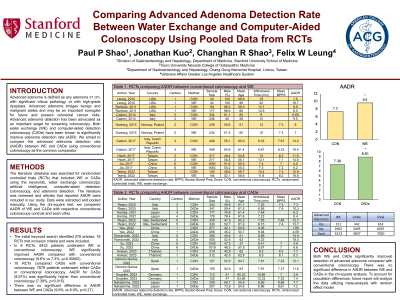Monday Poster Session
Category: Colon
P1608 - Comparing Advanced Adenoma Detection Rate Between Water Exchange and Computer-Aided Colonoscopy Using Pooled Data From Randomized Controlled Trials
Monday, October 23, 2023
10:30 AM - 4:15 PM PT
Location: Exhibit Hall

Has Audio

Paul P. Shao, MD
Stanford University
Redwood City, CA
Presenting Author(s)
Paul P. Shao, MD1, Jonathan Kuo, MS2, Changhan R. Shao, MBBS3, Felix W. Leung, MD, FACG4
1Stanford University, Redwood City, CA; 2Touro University Nevada, Henderson, NV; 3Linkou Chang Gung Memorial Hospital, Taoyuan City, Taoyuan, Taiwan; 4Sepulveda ACC/VAGLAHS/UCLA, North Hills, CA
Introduction: Advanced adenoma is defined as any adenoma ≥1 cm, with significant villous pathology, or with high-grade dysplasia. Advanced adenoma bridges benign and malignant states and may be an important surrogate for future and present colorectal cancer risks. Advanced adenoma detection has been advocated as an important target for screening colonoscopy. Both water exchange (WE) and computer-aided detection colonoscopy (CADe) have been shown to significantly improve adenoma detection rate (ADR). We aimed to compare the advanced adenoma detection rate (AADR) between WE and CADe using conventional colonoscopy as the common comparator.
Methods: The literature database was searched for randomized controlled trials (RCTs) that included WE or CADe using the keywords, water exchange colonoscopy, artificial intelligence, computer-aided detection colonoscopy, and adenoma detection. The literature was reviewed and articles that reported AADR were included in our study. Data were extracted and pooled manually. Using the chi-square test, we compared AADR of WE and CADe with respective conventional colonoscopy controls and each other.
Results: The initial keyword search identified 278 articles; 16 RCTs met inclusion criteria and were included in our study. In 8 RCTs, a total of 6432 patients underwent WE or conventional colonoscopy. WE significantly improved AADR compared with conventional colonoscopy (9.7% vs 7.3%, p=0.00062). Another 8 RCTs examined CADe and reported AADR. They included a total of 7032 patients who underwent either CADe or conventional colonoscopy. AADR for CADe (9.1%) was significantly higher than conventional colonoscopy (7.5%, p=0.0166). There was no significant difference in AADR between WE and CADe (9.7% vs 9.1%, p=0.39).
Discussion: Both WE and CADe significantly improved detection of advanced adenoma compared with conventional colonoscopy. There was no significant difference in AADR between WE and CADe in the chi-square analysis. To account for population differences, future report will analyze the data utilizing meta-analysis with random effect model.
Disclosures:
Paul P. Shao, MD1, Jonathan Kuo, MS2, Changhan R. Shao, MBBS3, Felix W. Leung, MD, FACG4. P1608 - Comparing Advanced Adenoma Detection Rate Between Water Exchange and Computer-Aided Colonoscopy Using Pooled Data From Randomized Controlled Trials, ACG 2023 Annual Scientific Meeting Abstracts. Vancouver, BC, Canada: American College of Gastroenterology.
1Stanford University, Redwood City, CA; 2Touro University Nevada, Henderson, NV; 3Linkou Chang Gung Memorial Hospital, Taoyuan City, Taoyuan, Taiwan; 4Sepulveda ACC/VAGLAHS/UCLA, North Hills, CA
Introduction: Advanced adenoma is defined as any adenoma ≥1 cm, with significant villous pathology, or with high-grade dysplasia. Advanced adenoma bridges benign and malignant states and may be an important surrogate for future and present colorectal cancer risks. Advanced adenoma detection has been advocated as an important target for screening colonoscopy. Both water exchange (WE) and computer-aided detection colonoscopy (CADe) have been shown to significantly improve adenoma detection rate (ADR). We aimed to compare the advanced adenoma detection rate (AADR) between WE and CADe using conventional colonoscopy as the common comparator.
Methods: The literature database was searched for randomized controlled trials (RCTs) that included WE or CADe using the keywords, water exchange colonoscopy, artificial intelligence, computer-aided detection colonoscopy, and adenoma detection. The literature was reviewed and articles that reported AADR were included in our study. Data were extracted and pooled manually. Using the chi-square test, we compared AADR of WE and CADe with respective conventional colonoscopy controls and each other.
Results: The initial keyword search identified 278 articles; 16 RCTs met inclusion criteria and were included in our study. In 8 RCTs, a total of 6432 patients underwent WE or conventional colonoscopy. WE significantly improved AADR compared with conventional colonoscopy (9.7% vs 7.3%, p=0.00062). Another 8 RCTs examined CADe and reported AADR. They included a total of 7032 patients who underwent either CADe or conventional colonoscopy. AADR for CADe (9.1%) was significantly higher than conventional colonoscopy (7.5%, p=0.0166). There was no significant difference in AADR between WE and CADe (9.7% vs 9.1%, p=0.39).
Discussion: Both WE and CADe significantly improved detection of advanced adenoma compared with conventional colonoscopy. There was no significant difference in AADR between WE and CADe in the chi-square analysis. To account for population differences, future report will analyze the data utilizing meta-analysis with random effect model.
Disclosures:
Paul Shao indicated no relevant financial relationships.
Jonathan Kuo indicated no relevant financial relationships.
Changhan Shao indicated no relevant financial relationships.
Felix Leung indicated no relevant financial relationships.
Paul P. Shao, MD1, Jonathan Kuo, MS2, Changhan R. Shao, MBBS3, Felix W. Leung, MD, FACG4. P1608 - Comparing Advanced Adenoma Detection Rate Between Water Exchange and Computer-Aided Colonoscopy Using Pooled Data From Randomized Controlled Trials, ACG 2023 Annual Scientific Meeting Abstracts. Vancouver, BC, Canada: American College of Gastroenterology.
